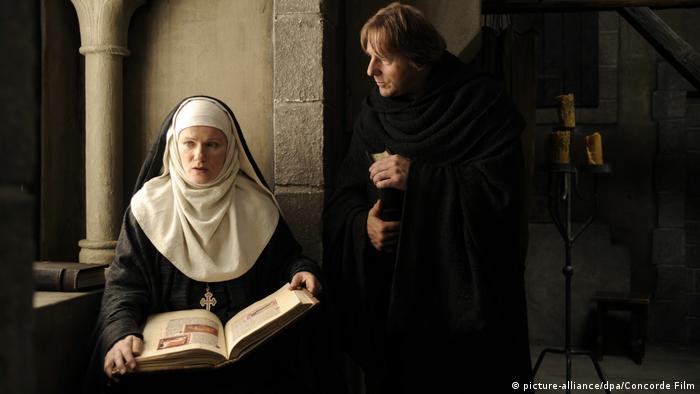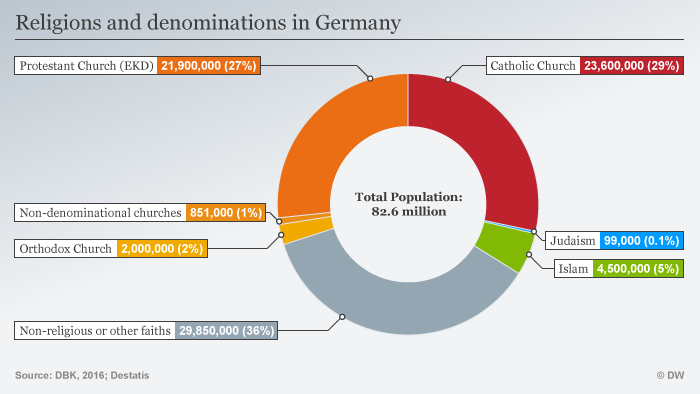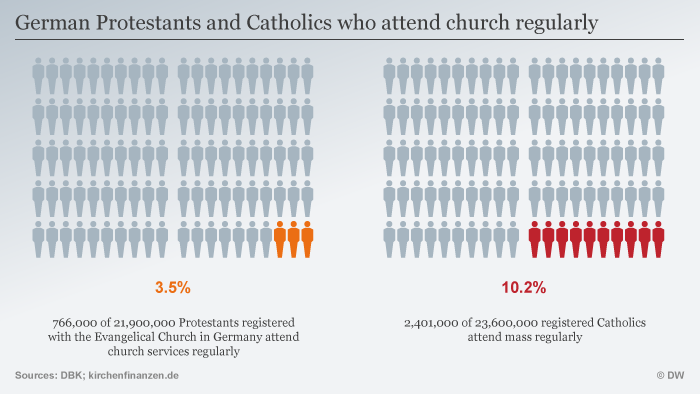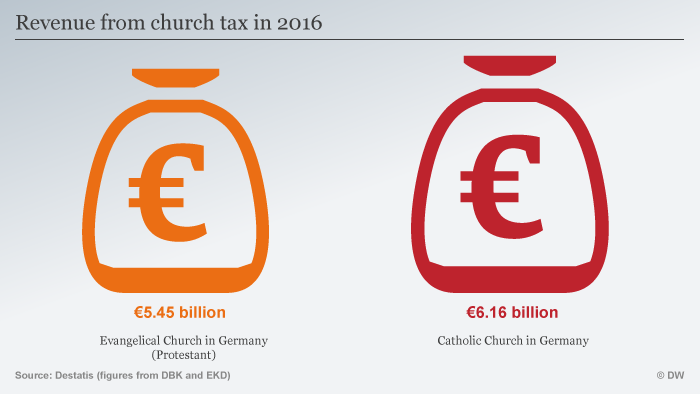6 facts about Catholic and Protestant influence in Germany
How Christian is Germany? Judging by a sharp decline in church attendance, not very. But a look at tax revenue, board memberships and land holdings suggest that its two biggest churches still have a wealth of influence.
The Holy Roman Empire, the birthplace of Protestantism, the battlefields of Christian theology. The lands that make up modern Germany once had front row seats to some of the most significant developments both in the history of Europe and of Christianity.
Today, those Christian roots are hard to overlook. Public holidays based in Catholic and Protestant beliefs provided highly-anticipated vacation days that go beyond just Christmas and Easter. And while “Christian” political parties — Angela Merkel’s Christian Democratic Union and the Bavarian Christian Socialist Union, for example — are considered traditional rather than religious, the parties’ names make it clear they were conceived on the basis of Christian values.
Yet the ubiquity of steeples, crosses and saints is deceptive: Churches are largely empty. With more and more Christians rejecting core tenets of the faith, including the existence of God, is it accurate for Germany to be considered a Christian nation?
DW looks at six facts and figures that shed light on the make-up of Catholic and Protestant identity and influence in Germany today.
Read more: How Martin Luther became the first Christian pop star
1. The majority of Germans identify as Christian
Roughly 48.4 million Germans identify as Christian, be they Catholic, Protestant, Orthodox or non-denominational. That’s nearly 60 percent of German society.
The Muslim population comprises approximately 5 percent (4.5 million) of the population; the Jewish community 0.1 percent (99,000).
Over 35 percent of the population belongs to another denomination or has registered as not belonging to any religious group.
2. Under 10 percent of Christians go to church regularly
The majority of Germany’s Christians are registered as either Catholic (23.6 million) or Protestant (21.9 million). The Protestant Church has its roots in Lutheranism and other denominations that rose out of the 16th-century religious reform movement. Despite the Protestant Church’s official name — the “Evangelical Church of Germany” (EKD) — it is not to be mistaken with the Evangelical movement in the United States.
What the numbers do not reveal is whether church members are practicing the Christian faith or simply preserving tradition. A look at attendance rates would support the notion that the majority of society is, in actuality, not religious.
According to the German Bishops’ Conference, only 10 percent of registered Catholics attend church on Sundays. Among Protestants, it’s 3 percent. Not only that, but churches are seeing fewer baptisms, brides and — where Protestants are concerned — burials: Between 2010 and 2015, church weddings declined by 8 percent among Catholics and 14 percent among Protestants.
During the same time period, an average of 167,000 Catholics and 180,000 Protestants officially left the church each year.
Read more: Anti-Christian crime causes increasing concern in Germany
3. Churches make billions despite falling numbers
In 2016, the Catholic Church and the Protestant Church collected a record-breaking €6.1 billion ($7.5 billion) and €5.5 billion ($6.8 billion) in church tax, respectively.
The right for churches to collect a de-facto membership fee in the form of a tax dates back to 1919, when the Weimar Republic introduced the measure to counter the financial aftermath of the separation of church and state.
The rate is currently set at 9 percent of one’s income for members above a minimum income threshold. The money helps keep parishes, church employees, daycares and other properties afloat.
And as the Finance Ministry handles the tax for them — neither church has the necessary infrastructure for such a massive undertaking — it also receives a neat 3 percent of the total, which added up to €348 million in 2016.
4. Land holdings also boost church wealth
Assessing the churches’ wealth is a tricky and tangled business due to their extensive land holdings and reparation payments they receive from the states.
The two churches own at least 830,000 hectares (8,300 square kilometers or 3,200 square miles) of land, according to an estimation by church critic Carsten Frerk, whose number is often cited by German media.
The churches themselves have disclosed tens of thousands of buildings that they each hold in addition to at least 14,100 Protestant and 10,800 Catholic churches. When examining buildings related to the churches’ roles in healthcare, education and charitable work, the Catholic Church has at least 66,000 additional holdings and the Protestant Church a further 50,000. They also lease an undisclosed number of properties to home owners and businesses nationwide.
Moreover, they receive state funds to compensate for property losses dating back to the early 1800s when Napoleon upended the Holy Roman Empire. According to broadcaster Deutschlandfunk, this amounted to nearly €500 million in 2017 and comes from tax payers whether they belong to a church or not.
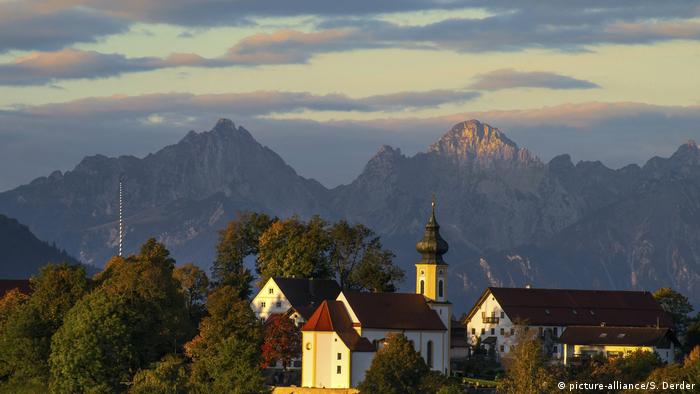 Chapels are easy to see, but harder to spot is where the churches own lands after centuries of property changing hands
Chapels are easy to see, but harder to spot is where the churches own lands after centuries of property changing hands
5. Church widely represented in public matters
Another reason Catholic and Protestant interests are so visible in German society is the seats church representatives are granted on supervisory boards across a wide variety of organizations. There, the churches sit alongside other interest groups such as conservationists, union leaders and experts from a range of fields in the name of representing an important demographic.
By way of example, the two churches have a voice on public broadcasting councils, from the nationwide ARD and ZDF to the regional WDR, to the international Deutsche Welle, which is financed by the Foreign Ministry. Included in these councils’ oversight tasks is helping to select the director general.
Given the innumerable supervisory boards across Germany, it is next to impossible to know exactly how many of these seats are held by the churches.
It is also not uncommon for members of the German parliament to be involved in the Central Committee of Catholics (ZDK) or the synod of the German Evangelical Church (EKD). Nominated as private citizens and not as representatives of their parties, these individuals are among several hundred laity who help set each church’s agenda.
They are also expected to represent church interests in the public sphere — though how this interacts with their roles in public political office is unclear.
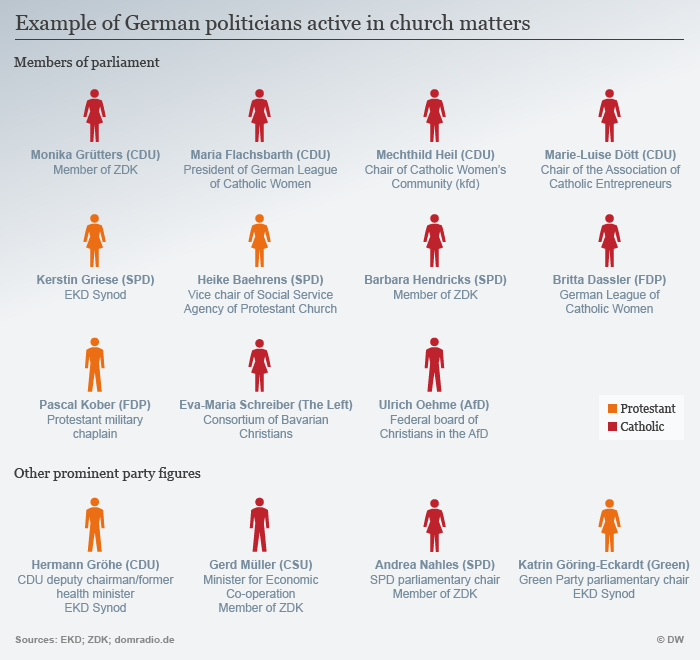
Read more: The main differences between Catholics and Protestants
6. Fewer Christians believe in core tenets of their faith
When asked by German pollster INSA in 2017 if they believed in the resurrection of Jesus Christ, only 52 percent of Catholics and 48 percent of Protestants said yes. When asked if they believed in life after death, only 40 percent of Catholics and 32 percent of Protestants said they did.
Additionally, the research institute Emnid asked Christians whether they believed in God. Roughly 24 percent of Protestants and 11 percent of Catholics said no, according to newspaper Tagesspiegel.
These surveys clearly point to a German society in which many people do not equate Christian identity with doctrinal belief. This, in turn, raises the question of the extent to which the Catholic and Protestant Churches use their influential positions in the German state and society to act in the interest of their combined 45 million members.
Source: http://www.dw.com/en/6-facts-about-catholic-and-protestant-influence-in-germany/a-43081215
